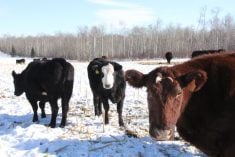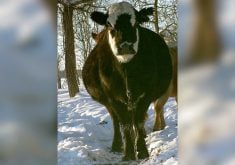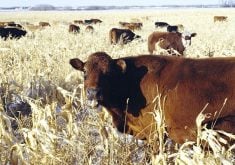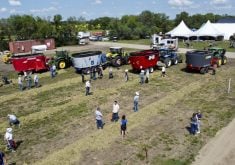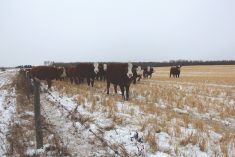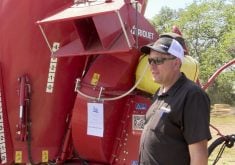A lot of farmers only see one type of cost when it comes to feeding cattle. They see the feed cost. However, there are other costs which are often overlooked. This would be the act of feeding, also called the yardage cost. The reason this is not always included is because it is not a cash-out-of-pocket item. Simply put, the feed cost is the price of the feed and the delivery of that feed to your farm.
Yardage is the labour and equipment costs involved, the time, fuel, repairs, depreciation and opportunity costs that go into the work of feeding livestock.
Read Also

Canadian Beef Check-Off Agency reports on investments and activities
The check-off agency’s work behind the scenes is what ensures cattle check-off dollars are invested wisely, accounted for transparently and deliver measurable value back to producers and importers.
Some might call this “unpaid labour” but I despise that term. Yes, sometimes in a bad year we don’t make as much profit as planned, but to plan a profit centre that includes unpaid labour, that’s insane.
What is the feed cost? Let’s look at feeding hay in this example. Say the price of hay you buy this year is worth $0.04/lb., so a 1,200-lb. bale of hay is worth $48. The market sets this price for feed. It can change every year and most people call this a variable cost.
But I can’t control it; market value is pretty much market value. So does that make it fixed? I have to pay what the market dictates. Whether you buy hay or make it yourself, it is still worth the same market value for the same type and quality.
Yardage, however, can be different depending on how I feed that hay. This is usually considered a fixed cost in most types of analysis, but I have the ability to change it! So is this then the variable cost?
To get a true yardage cost takes quite a bit of work and it takes a lot of direct costs and overall business costs into account. But I like to make things simple, so here is my from-the-hip yardage cost.
First, give your equipment cost an hourly rate. Make sure it is a reasonable rate similar to any other type of equipment of similar value from other industries. For example, I can hire a rubber-tired backhoe to do some work for me at $100/hour. This includes the operator. Is this what a similar-sized farm tractor should be worth? You tell me, it’s your farm.
I value my bale truck at $65/hour as it is an older truck and is pretty much depreciated (including the driver). In this hourly rate, the fuel, oil, repairs, maintenance, depreciation, opportunity cost and any other business overhead costs should be all covered if your rate is realistic.
Now, how many hours a day does it take to feed your herd? Let’s say in our example we have 200 head and it takes on average 1.5 hours a day to feed and bed them. 1.5 hours at $100/hour divided by 200 head gives you a yardage cost of $0.75/head/day. Now add in the $1.28 (32 lbs./head/day at $0.04/lbs.) for feed costs, and you end up with a $2.03/head/day. Be honest with yourself. Time yourself from the time you turn the key to when you turn it off again. I’ve seen farms where yardage alone is over $2/head/day.
Bale grazing on the other hand, allows me to lower my yardage a great deal. If I have the bales delivered to the field by the hay supplier for bale grazing, all I need to do is pull the twine. If I pull twine at 25 bales/hour, and I charge for my quad or snowmobile sitting there turned off at $50/hour, so five bales a day costs me about $0.05/head/day. For a five-day graze period I would need 25 bales per paddock and it would take me an hour to pull twine.
Some years I have a semi self-unload the hay in my pasture. I then have to set my bales out with my bale truck (100 bales/hour at $65), take the twine off (35 bales/hour at $25), and then ration that feed off with an electric fence all winter (1/2 hour twice a week at $50 an hour), my yardage would be a bit higher. With the same number of cows feeding the same ration it would be about $0.12/head/day. Every year is different and every farm is different.
Do your own numbers to see but include all your labour and equipment costs. I’ve heard the average yardage rate for Alberta is around $0.70/head/day. A difference of $0.58 in our example. ($0.70 – $0.12)
The biggest issue with bale grazing for most producers is the thought of cows wasting all that expensive feed. Is it really waste? At Greener Pastures Ranching, every day that a dry cow is bale grazed with imported feed, I charge out $0.30/head/day in fertilizer costs to my grazing profit centre payable to my feeding profit centre. If I did not feed on my land, I would not be getting the fertility. So is my feed cost $0.30 cheaper than I think? ($1.28 – $0.30 = $0.98/head/day plus yardage) I think so because I’ve seen the pasture improvement after bale grazing. I have seen a paddock covered by bale grazing, more than double the following year compared to an un-bale-grazed paddock. And that improvement continues on for at least five years or more. Why do I say “with imported feed”? If you are using your own feed off land you manage, you are only transferring nutrients around from one field to another. It is not a net gain because of the cows. It’s still good for the production but don’t credit the $0.30/head/day to the cows.
Feed is a bigger factor than yardage, right? Wrong, let’s assume that with bale grazing, I’m going to leave more feed on the ground, but for the difference of $0.58 I can save on yardage, I can waste a lot of feed. Even if I waste 15 per cent of the bale, (which I think is quite high) that only costs me about $0.19/head/day in waste. (1,300 lbs. x 15% = 195 lbs. x 5 bales = 975 lbs. at $0.04/lb. = $39 ÷ 200 cows = $0.19/head/day) But that $0.19 is fertilizer for the next five to 10 years. (And this is assuming we waste no feed with our alternative method of feeding.) Most farmers don’t worry about how high their yardage costs are, but panic if there is feed waste. If I save $0.58 on my yardage at a waste cost of $0.19, I see it as a no-brainer. Plus I get the fertilizer next spring.
Let’s use my fertilizer value and see, 200 cows at $0.30/head/day for 200 days equals $12,000 worth of fertilizer value. For free! It was only a management decision that caused it. I also saved all those labour and equipment costs in the process.
In addition to the “waste,” most producers are concerned with “dead spots” after bale grazing. This is the impeded growth the following summer due to the extra residue left covering the ground. I have found that the grass quite easily grows through the bale circles by midsummer.
Dead spots depend on what type of feed you used, how palatable it was and how well you made them clean up. It will take longer for the grass to grow through mature green feed or straw residue than good hay. I have had pea straw bales that left dead spots for up to four years. But normally on my ranch with decent quality feed, I have very little impeded growth the following year. The tendency is to want to harrow the residue. I never do. I would need to own the tractor and the harrows, burn the fuel, and spend the time turning circles. And I see no economic benefit to any of it. My time is more valuable than that. If you have dead spots, don’t stress over it. It will grow.
Bale grazing — it’s an easy sell. It saves you time and money and does a fantastic job at pasture rejuvenation. It just makes “cents.”




